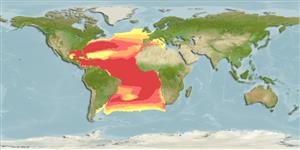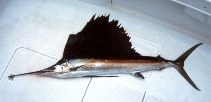Istiophorus albicans (Latreille, 1804)
Atlantic sailfish
Add your observation in Fish Watcher
| Native range | All suitable habitat | Point map | Year 2050 |

|
| This map was computer-generated and has not yet been reviewed. |
| Istiophorus albicans AquaMaps Data sources: GBIF OBIS |
Upload your photos and videos
Pictures | Videos | Stamps, coins, misc. | Google imageIstiophorus albicans
Picture by Baumeier, E.
Pictures | Videos | Stamps, coins, misc. | Google imageIstiophorus albicans
Picture by Baumeier, E.
Common names from other countries
Classification / Names Κοινά ονόματα | Συνώνυμα | Catalog of Fishes(Γένος, Είδη) | ITIS | CoL | WoRMS | Cloffa
> Carangiformes (Jacks) > Istiophoridae (Billfishes)
Etymology: Istiophorus: Greek, istios = sail + Greek, pherein = to carry (Ref. 45335).
Etymology: Istiophorus: Greek, istios = sail + Greek, pherein = to carry (Ref. 45335).
Issue
This species is synonym of Istiophorus platypterus in Eschmeyer (CofF ver. Jan. 2018) according to Collette et al., 2006 (Ref. 84358). Several authors consider it as a valid species.
Environment: milieu / climate zone / depth range / distribution range Οικολογία
Θαλασσινό(ά); ωκεανόδρομο(ς) (Ref. 51243); εύρος βάθους 0 - 200 m (Ref. 43). Subtropical; 21°C - 28°C (Ref. 43); 56°N - 55°S, 99°W - 18°E (Ref. 43)
Κατανομή Χώρες | Περιοχές FAO | Οικοσυστήματα | Παρουσίες | Point map | Εισαγωγές | Faunafri
Atlantic Ocean: in tropical and temperate waters approximately 40°N in the northwest Atlantic, 50°N in the northeast Atlantic, 40°S in the southwest Atlantic, and 32°S in the southeast Atlantic. Migrating to Mediterranean Sea, mostly based on juvenile specimens. Highly migratory species.
Length at first maturity / Μέγεθος / Βάρος / Age
Maturity: Lm 133.5, range 121 - 146 cm
Max length : 315 cm TL αρσενικό/απροσδιόριστο; (Ref. 43); common length : 240 cm TL αρσενικό/απροσδιόριστο; (Ref. 5217); μεγ. δημοσιευμένο βάρος: 58.1 kg (Ref. 43); μεγ. αναφερόμενη ηλικία: 4 έτη (Ref. 72497)
Max length : 315 cm TL αρσενικό/απροσδιόριστο; (Ref. 43); common length : 240 cm TL αρσενικό/απροσδιόριστο; (Ref. 5217); μεγ. δημοσιευμένο βάρος: 58.1 kg (Ref. 43); μεγ. αναφερόμενη ηλικία: 4 έτη (Ref. 72497)
Short description Κλείδες προσδιορισμού | Μορφολογία | Μορφομετρία
Ραχιαίες άκανθες (συνολικά) : 0; Μαλακές ραχιαίες ακτίνες (συνολικά) : 48 - 53; Εδρικές άκανθες: 0; Μαλακές εδρικές ακτίνες: 9 - 12; Σπόνδυλοι: 24.
Usually found in the upper layers of warm water above the thermocline, but also capable of descending to rather deep water. Often migrate into near-shore waters. Occasionally form schools or smaller groups of 3 to 30 individuals, but often occur in loose aggregations over a wide area. Feed mainly on small pelagic fishes but also takes bottom-dwelling organisms. Females grow larger (Ref. 4770). Utilized fresh, canned and frozen; eaten steamed (Ref. 9987).
Life cycle and mating behavior Γεννητική Ωρίμανση | Αναπαραγωγή | Γεννοβολία | Αβγά | Γονιμότητα | Προνύμφες
Around Florida in USA, this species often moves inshore into shallow waters where females, swimming sluggishly with their dorsal fins extended and accompanied each by one or more males, may spawn near the surface in the warm season. However, spawning in offshore waters beyond the 100 fathom isobath was also reported from south of Cuba to Carolina, USA. Off southeast Florida, a 33.4 kg female may shed up to 4.8 million eggs in three batches during one spawning season.
Main reference
Upload your references | Αναφορές | Συντονιστής | Συνεργάτες
Nakamura, I., 1985. FAO species catalogue. Vol. 5. Billfishes of the world. An annotated and illustrated catalogue of marlins, sailfishes, spearfishes and swordfishes known to date. FAO Fish. Synop. 125(5):65p. Rome: FAO. (Ref. 43)
Threat to humans
Harmless
Human uses
αλιεία: Εμπορικό(ά); αλιεία αναψυχής: ναί
FAO(αλιεία: Παραγωγή; publication : search) | FishSource | Η θάλασσα γύρω μας
Περισσότερες πληροφορίες
Population dynamics
Παράμετροι Αύξησης
Max. ages / sizes
Length-weight rel.
Length-length rel.
Length-frequencies
Mass conversion
Στρατολόγηση
Αφθονία
Παράμετροι Αύξησης
Max. ages / sizes
Length-weight rel.
Length-length rel.
Length-frequencies
Mass conversion
Στρατολόγηση
Αφθονία
Life cycle
Αναπαραγωγή
Γεννητική Ωρίμανση
Γονιμότητα
Γεννοβολία
Spawning aggregations
Αβγά
Egg development
Προνύμφες
Δυναμική προνυμφών
Αναπαραγωγή
Γεννητική Ωρίμανση
Γονιμότητα
Γεννοβολία
Spawning aggregations
Αβγά
Egg development
Προνύμφες
Δυναμική προνυμφών
Anatomy
Επιφάνεια βραγχίων
Brain
Otolith
Επιφάνεια βραγχίων
Brain
Otolith
Physiology
Body composition
Nutrients
Κατανάλωση οξυγόνου
Κολυμβητικός τύπος
Ταχύτητα κολύμβησης
Visual pigments
Fish sound
Diseases & Parasites
Toxicity (LC50s)
Body composition
Nutrients
Κατανάλωση οξυγόνου
Κολυμβητικός τύπος
Ταχύτητα κολύμβησης
Visual pigments
Fish sound
Diseases & Parasites
Toxicity (LC50s)
Genetics
Γενετική
Heterozygosity
Κληρονομικότητα
Γενετική
Heterozygosity
Κληρονομικότητα
Human related
Aquaculture systems
Προφίλ υδατοκαλλιεργειών
Στελέχοι
Ciguatera cases
Stamps, coins, misc.
Aquaculture systems
Προφίλ υδατοκαλλιεργειών
Στελέχοι
Ciguatera cases
Stamps, coins, misc.
Εργαλεία
E-book | Οδηγός πεδίου | Κλείδες προσδιορισμού | Ανάλυση κατά μήκος συνθέσεων | Εργαλείο ιστορίας ζωής | Σημειακός χάρτης | Classification Tree
| Catch-MSY |
Special reports
Download XML
Διαδικτυακές πηγές
Aquatic Commons | BHL | Cloffa | Websites from users | Check FishWatcher | CISTI | Catalog of Fishes(Γένος, Είδη) | DiscoverLife | ECOTOX | Faunafri | Fishtrace | GenBank(genome, nucleotide) | GloBI | GOBASE | | Google Books | Google Scholar | Google | IGFA World Record | MitoFish | Εθνικές βάσεις δεδομένων | Otolith Atlas of Taiwan Fishes | PubMed | Reef Life Survey | Scirus | SeaLifeBase | Δέντρο Ζωής | Wikipedia(Go, αναζήτηση) | World Records Freshwater Fishing | Zoological Record
Estimates based on models
Preferred temperature (Ref. 115969): 16.3 - 27.4, mean 23.5 (based on 431 cells).
Phylogenetic diversity index (Ref. 82804): PD50 = 0.7505 [Uniqueness, from 0.5 = low to 2.0 = high].
Bayesian length-weight: a=0.00447 (0.00195 - 0.01025), b=3.14 (2.94 - 3.34), in cm Total Length, based on LWR estimates for this (Sub)family-body shape (Ref. 93245).
Τροφικό Επίπεδο (Ref. 69278): 4.5 ±0.4 se; based on diet studies.
Ελαστικότητα (Ref. 120179): Μεσαίο(α), ελάχιστος χρόνος για διπλασιασμό πληθυσμού 1,4 - 4,4 έτη (K=0.29-1.2 (?); tm=3.5).
Prior r = 0.19, 95% CL = 0.13 - 0.29, Based on 3 full stock assessments.
Fishing Vulnerability (Ref. 59153): High vulnerability (60 of 100).
Climate Vulnerability (Ref. 125649): Moderate vulnerability (42 of 100).




